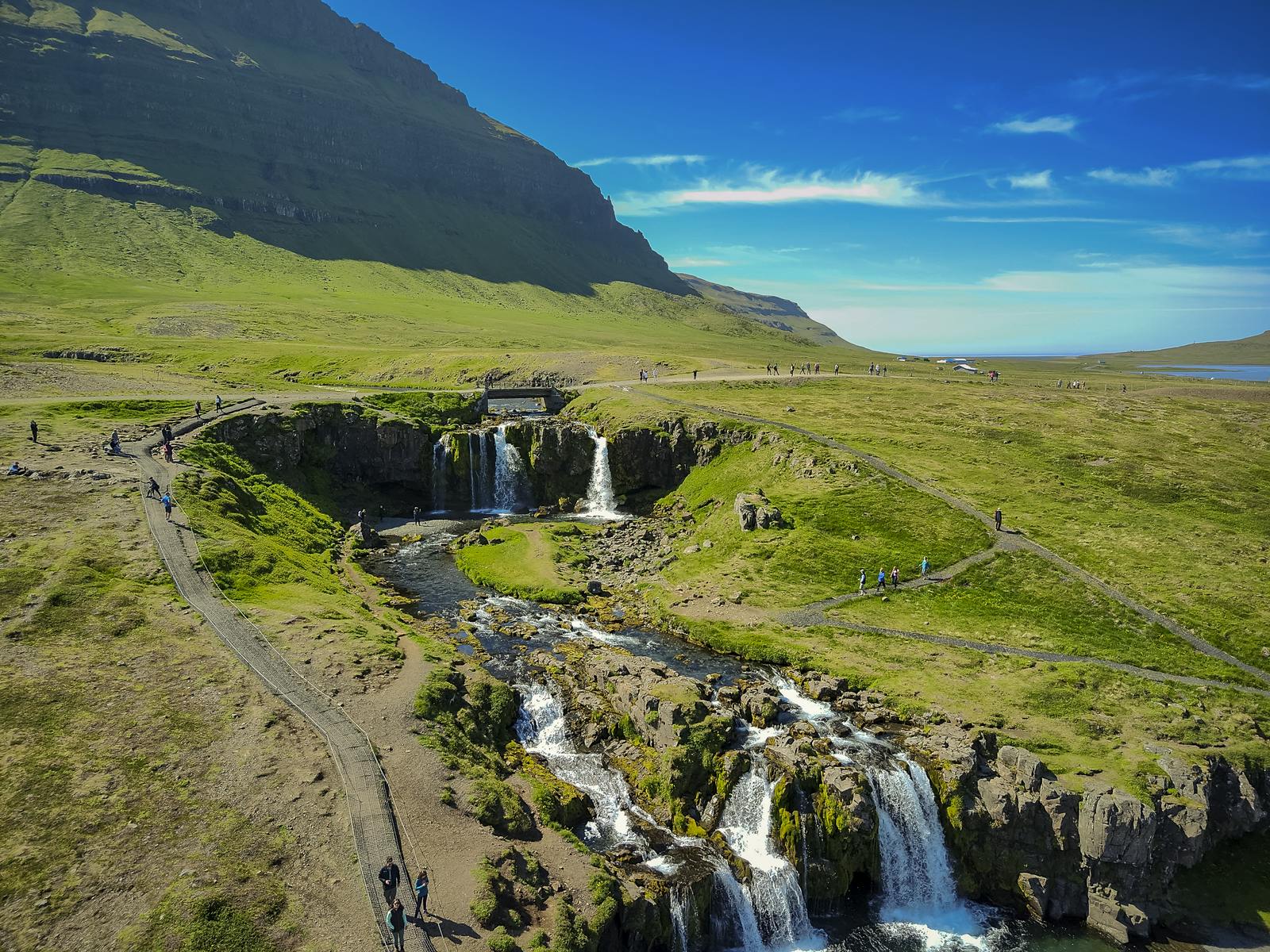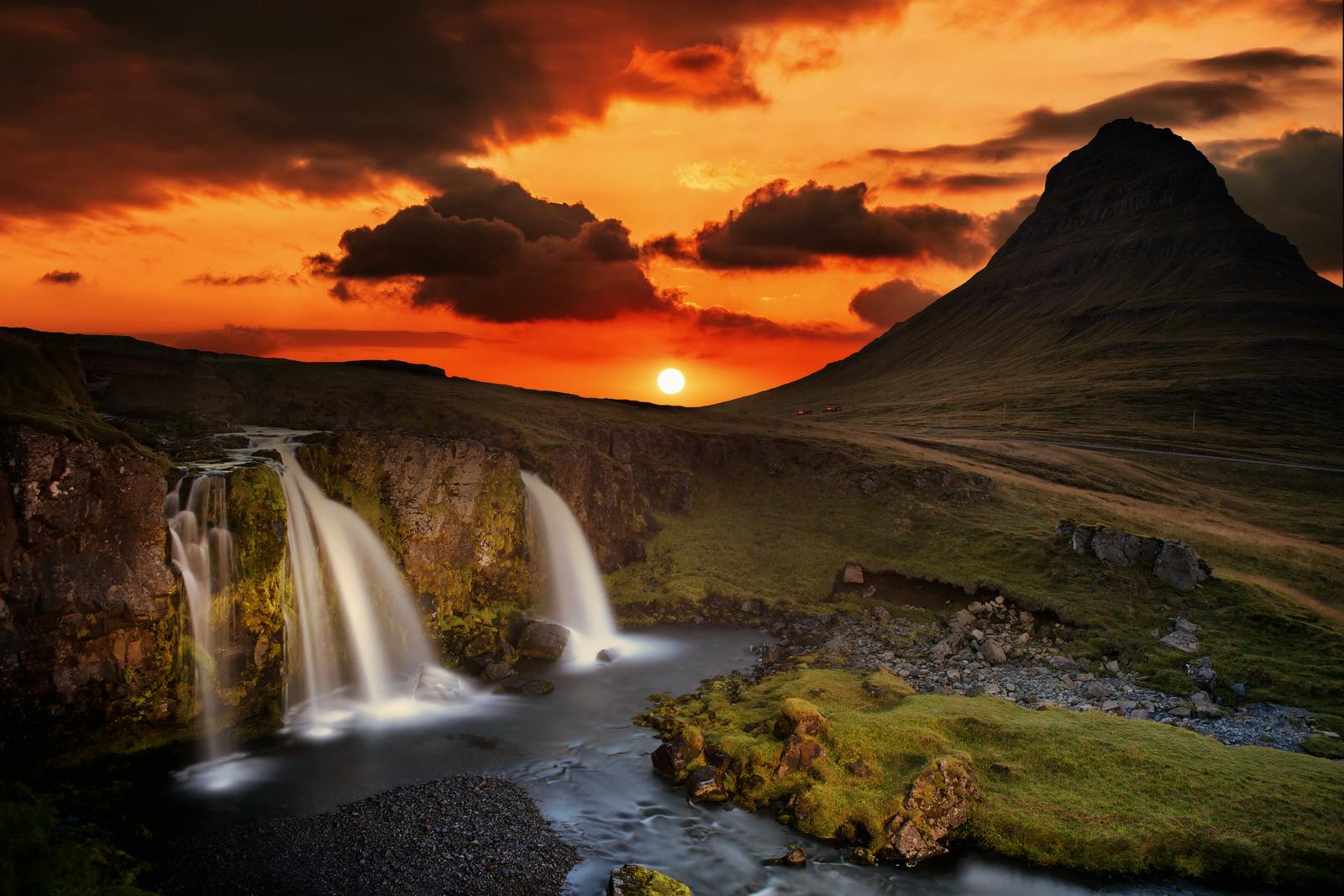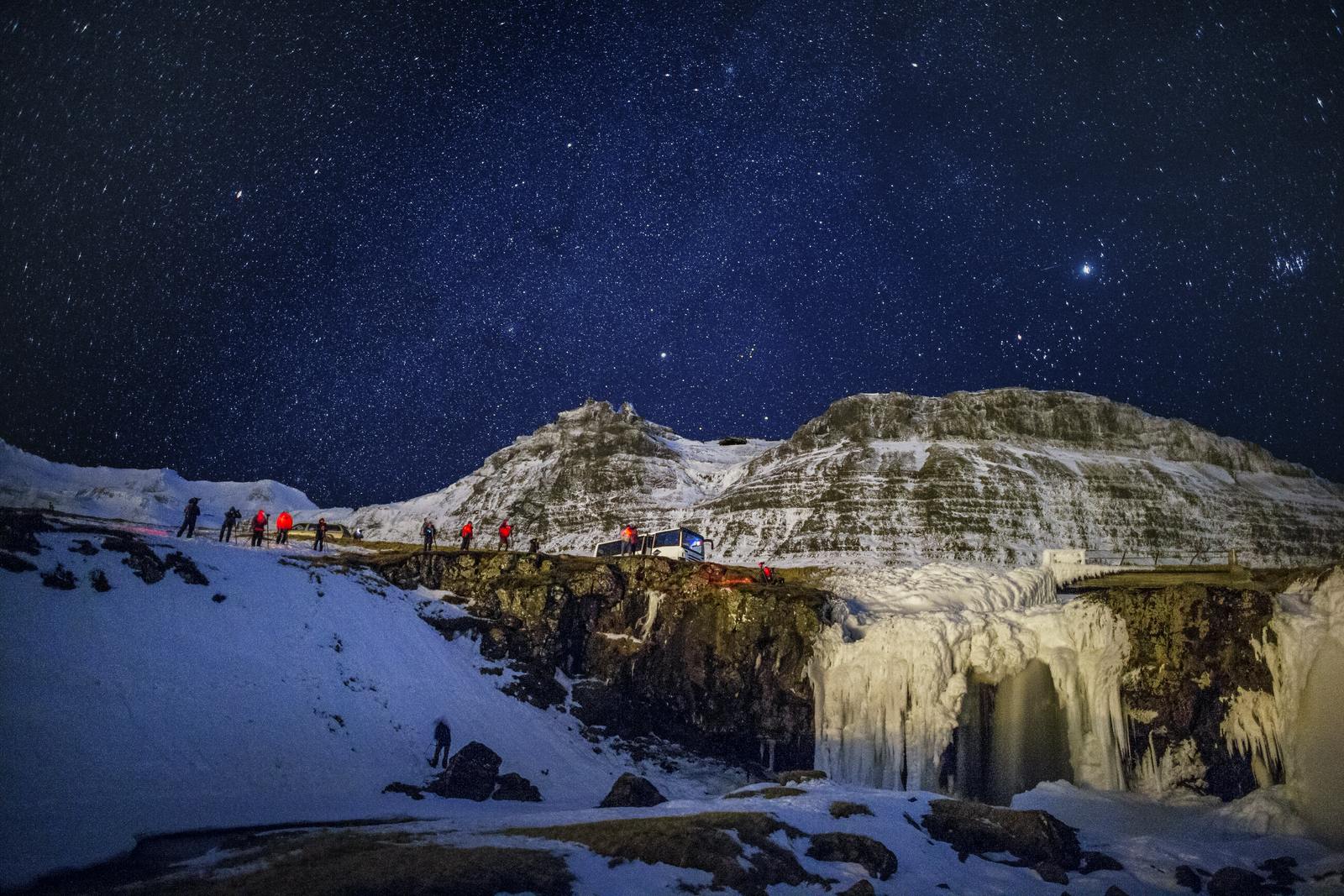
Guide to Kirkjufellsfoss Waterfall in Iceland
Nestled at the base of Kirkjufell mountain on the Snæfellsnes Peninsula, Kirkjufellsfoss is a small but captivating waterfall that graces the Icelandic landscape. Its name translates to "Church Mountain Falls," a nod to the distinctive shape of Kirkjufell Mountain that rises majestically behind it, resembling a church steeple.
As you approach the falls, the symphony of cascading water becomes increasingly audible. Kirkjufellsfoss is not just a standalone waterfall; it is part of a scenic ensemble that includes the mountain, lush greenery, and a river that gracefully flows through the landscape. The combination of these elements creates a picturesque scene that has earned Kirkjufellsfoss its place as one of Iceland's most photographed locations.

Kirkjufellsfoss in Different Seasons
Kirkjufellsfoss transforms its appearance and ambience with each passing season, offering visitors a unique and ever-changing experience. Here's how Kirkjufellsfoss looks and feels in different seasons:
Winter (December to February)
- Snow-Covered Landscape: The surrounding landscape, including Kirkjufell Mountain and the waterfall, may be covered in a blanket of snow, creating a picturesque winter wonderland.
- Frozen Cascades: In colder temperatures, the waterfall's cascades may partially freeze, forming intricate ice formations that add to the enchanting atmosphere.
- Winter Activities: Visitors during this season may have the opportunity to witness the Northern Lights, especially during the dark winter nights. The snow-covered scenery provides a stunning backdrop for photography.
Spring (March to May)
- Melting Snow: As temperatures rise, the snow begins to melt, revealing vibrant greenery beneath. The melting snow influences the waterfall's flow, creating a dynamic and lively scene.
- Blooming Flora: Spring brings the emergence of colourful wildflowers and blossoming vegetation, adding bursts of colour to the landscape.
- Increased Flow: With the melting snow and potential rainfall, Kirkjufellsfoss experiences a heightened flow, creating a more powerful and dynamic waterfall.
Summer (June to August)
- Lush Greenery: Summer transforms the surroundings into a lush green paradise. The grass and vegetation are at their peak, providing a vibrant backdrop to the waterfall.
- Long Days: Iceland experiences the Midnight Sun during the summer months, providing extended daylight hours for exploration and photography well into the evening.
- Milder Temperatures: While still relatively cool, summer temperatures are more moderate, making it a comfortable time to visit the waterfall and explore the nearby trails.

Autumn (September to November)
- Fall Foliage: The landscape transitions to warm autumn hues, with the foliage turning shades of red, orange, and yellow. This creates a stunning contrast against the dark basalt rocks.
- Decreased Tourist Crowds: Compared to the summer months, the autumn season sees fewer tourists, offering a quieter and more serene experience.
- Variable Weather: Autumn can bring a mix of clear days and stormy weather, providing diverse photographic opportunities.
How Did Kirkjufellsfoss Form?
By visiting Perlan in Reykjavík, you can gain a better understanding of how Kirkjufellsfoss and other waterfalls in Iceland were formed. This museum has multiple floors of exciting exhibitions that dive deeper into different subjects of Iceland and its natural wonders. You can learn how natural forces, such as Kirkjufellsfoss, have shaped Iceland's landscape.
Kirkjufell in Icelandic Folklore
Before delving into the specifics of Kirkjufellsfoss, it's essential to understand the mythical aura that enshrouds Kirkjufell Mountain. The mountain is often considered one of the most beautiful in Iceland, and it has earned a place in local folklore.
According to Icelandic mythology, Kirkjufell is sometimes referred to as the "Sorcerer's Hat" or "Wizard's Hat." Legend has it that the mountain is a gathering place for mystical beings, and its unique shape is said to be the result of a battle between two mighty trolls. The trolls, frozen by the first light of day, are said to have become Kirkjufell and the nearby mountain, Grundarfjall.
This enchanting narrative adds an extra layer of magic to the landscape, making Kirkjufell and its surrounding areas not just a physical destination but a canvas for the imagination, where mythical tales blend seamlessly with natural beauty.

Kirkjufellsfoss On Screen
Kirkjufellsfoss and the nearby Kirkjufell Mountain have gained international recognition for their stunning beauty, and as a result, they have been featured in various films, television shows, and commercials. One notable example is their appearance in the popular television series "Game of Thrones."
Kirkjufellsfoss: A Photographers Dream
Now, let's shift our focus to Kirkjufellsfoss itself. The waterfall is a charming addition to the already captivating scenery. The water flows gracefully down a series of steps, creating a delicate veil that contrasts with the ruggedness of the mountainous backdrop.
What makes Kirkjufellsfoss particularly special is the interplay between the waterfall and Kirkjufell Mountain. Photographers and nature enthusiasts alike are drawn to the unique compositions that can be captured from different vantage points. Whether it's the reflection of the mountain in the calm waters or the dynamic contrast of the waterfall against the towering peak, Kirkjufellsfoss offers endless possibilities for those seeking to capture the essence of Iceland's natural beauty.
How to Get to Kirkjufellsfoss From Reykjavík
When driving, the distance from Reykjavik to Kirkjufellsfoss is approximately 175 kilometres (about 109 miles). The travel time can vary depending on factors such as road conditions, weather, and the chosen route. Under normal circumstances with good road conditions, the drive from Reykjavik to Kirkjufellsfoss typically takes approximately 2.5 to 3 hours.
Once you have parked in the nearby parking area, a short and well-marked trail leads you to Kirkjufellsfoss. The walk is relatively easy, allowing you to soak in the scenery and build anticipation as you approach the waterfall.

Step-by-step Guide To Kirkjufellsfoss
- Begin in Reykjavík city centre and take northward on Route 1, also known as the Ring Road. This main highway circles the island and provides a well-maintained route for travellers.
- After approximately 70 kilometres (43 miles), near the town of Borgarnes, take the turn onto Route 54. This road will lead you onto the Snæfellsnes Peninsula, where Kirkjufellsfoss is located.
- Continue on Route 54 as it takes you across the Snæfellsnes Peninsula. The drive is a picturesque adventure, showcasing diverse landscapes from coastal views to volcanic terrain. Along the way, you may encounter charming towns like Stykkishólmur and Arnarstapi, offering opportunities for exploration and additional sightseeing.
- As you approach the town of Grundarfjörður on Route 54, you'll catch glimpses of the iconic Kirkjufell mountain in the distance. This distinctive peak serves as a visual landmark guiding you toward Kirkjufellsfoss.
- Grundarfjörður is the nearest town to Kirkjufellsfoss and Kirkjufell mountain. Here, you can find amenities, accommodation options, and the starting point for your visit to the waterfall.
- From Grundarfjörður, it's a short drive to Kirkjufellsfoss. Follow the signs or use GPS navigation to guide you to the parking area near the falls.
Kirkjufellsfoss FAQ
How Long Is The Hike To Kirkjufellsfoss?
It is a short and easy hike from the parking area near the waterfall.
Where Is Kirkjufellsfoss?
Kirkjufellsfoss is near the town of Grundarfjörður, in Snæfellsnes Peninsula.
How Tall Is Kirkjufellsfoss?
Kirkjufellsfoss is approximately 5 metres (16 feet) tall.







